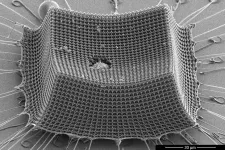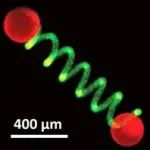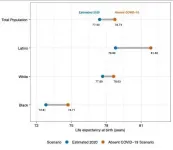INFORMATION:
This research was supported, in part, by the U.S. Office of Naval Research, the Vannevar Bush Faculty Fellowship, and the U.S. Army Research Office through the Institute for Soldier Nanotechnologies at MIT.
Written by Jennifer Chu, MIT News Office
Ultralight material withstands supersonic microparticle impacts
The new carbon-based material could be a basis for lighter, tougher alternatives to Kevlar and steel
2021-06-24
(Press-News.org) A new study by engineers at MIT, Caltech, and ETH Zürich shows that "nanoarchitected" materials -- materials designed from precisely patterned nanoscale structures -- may be a promising route to lightweight armor, protective coatings, blast shields, and other impact-resistant materials.
The researchers have fabricated an ultralight material made from nanometer-scale carbon struts that give the material toughness and mechanical robustness. The team tested the material's resilience by shooting it with microparticles at supersonic speeds, and found that the material, which is thinner than the width of a human hair, prevented the miniature projectiles from tearing through it.
The researchers calculate that compared with steel, Kevlar, aluminum, and other impact-resistant materials of comparable weight, the new material is more efficient at absorbing impacts.
"The same amount of mass of our material would be much more efficient at stopping a projectile than the same amount of mass of Kevlar," says the study's lead author, Carlos Portela, assistant professor of mechanical engineering at MIT.
If produced on a large scale, this and other nanoarchitected materials could potentially be designed as lighter, tougher alternatives to Kevlar and steel.
"The knowledge from this work... could provide design principles for ultra-lightweight impact resistant materials [for use in] efficient armor materials, protective coatings, and blast-resistant shields desirable in defense and space applications," says co-author Julia R. Greer, a professor of materials science, mechanics, and medical engineering at Caltech, whose lab led the material's fabrication.
The team, which reports its results today in the journal Nature Materials, includes David Veysset, Yuchen Sun, and Keith A. Nelson, of MIT's Institute for Soldier Nanotechnologies and the Department of Chemistry, and Dennis M. Kochmann of ETH Zürich.
From brittle to bendy
A nanoarchitected material consists of patterned nanometer-scale structures that, depending on how they are arranged, can give materials unique properties such as exceptional lightness and resilience. As such, nanoarchitected materials are seen as potentially lighter, tougher impact-resistant materials. But this potential has largely been untested.
"We only know about their response in a slow-deformation regime, whereas a lot of their practical use is hypothesized to be in real-world applications where nothing deforms slowly," Portela says.
The team set out to study nanoarchitected materials under conditions of fast deformation, such as during high-velocity impacts. At Caltech, they first fabricated a nanoarchitected material using two-photon lithography, a technique that uses a fast, high-powered laser to solidify microscopic structures in a photosensitive resin. The researchers constructed a repeating pattern known as a tetrakaidecahedron -- a lattice configuration composed of microscopic struts.
"Historically this geometry appears in energy-mitigating foams," says Portela, who chose to replicate this foam-like architecture in a carbon material at the nanoscale, to impart a flexible, impact-absorbing property to the normally stiff material. "While carbon is normally brittle, the arrangement and small sizes of the struts in the nanoarchitected material gives rise to a rubbery, bending-dominated architecture."
After patterning the lattice structure, the researchers washed away the leftover resin and placed it in a high-temperature vacuum furnace to convert the polymer into carbon, leaving behind an ultralight, nanoarchitected carbon material.
Faster than the speed of sound
To test the material's resilience to extreme deformation, the team performed microparticle impact experiments at MIT using laser-induced particle impact tests. The technique aims an ultrafast laser through a glass slide coated with a thin film of gold, which itself is coated with a layer of microparticles -- in this case, 14-micron-wide silicon oxide particles. As the laser passes through the slide, it generates a plasma, or a rapid expansion of gas from the gold, which pushes the silicon oxide particles out in the direction of the laser. This causes the microparticles to rapidly accelerate toward the target.
The researchers can adjust the laser's power to control the speed of the microparticle projectiles. In their experiments, they explored a range of microparticle velocities, from 40 to 1,100 meters per second, well within the supersonic range.
"Supersonic is anything above approximately 340 meters per second, which is the speed of sound in air at sea level," Portela says. "So, some experiments achieved twice the speed of sound, easily."
Using a high-speed camera, they captured videos of the microparticles making impact with the nanoarchitected material. They had fabricated material of two different densities -- the less dense material had struts slightly thinner than the other. When they compared both materials' impact response, they found the denser one was more resilient, and microparticles tended to embed in the material rather than tear straight through.
To get a closer look, the researchers carefully sliced through the embedded microparticles and the materials, and found in the region just below an embedded particle the microscopic struts and beams had crumpled and compacted in response to the impact, but the surrounding architecture remained intact.
"We show the material can absorb a lot of energy because of this shock compaction mechanism of struts at the nanoscale, versus something that's fully dense and monolithic, not nanoarchitected," Portela says.
Interestingly, the team found they could predict the kind of damage the material would sustain by using a dimensional analysis framework for characterizing planetary impacts. Using a principle known as the Buckingham-Π theorem, this analysis accounts for various physical quantities, such as a meteor's velocity and the strength of a planet's surface material, to calculate a "cratering efficiency," or the likelihood and extent to which a meteor will excavate a material.
When the team adapted the equation to the physical properties of their nanoarchitected film and the microparticles' size and velocities, they found the framework could predict the kind of impacts that their experimental data showed.
Going forward, Portela says the framework can be used to predict the impact resilience of other nanoarchitected materials. He plans to explore various nanostructured configurations, as well as other materials beyond carbon, and ways to scale up their production -- all with the goal of designing tougher, lighter protective materials.
"Nanoarchitected materials truly are promising as impact-mitigating materials," Portela says. "There's a lot we don't know about them yet, and we're starting this path to answering these questions and opening the door to their widespread applications."
ELSE PRESS RELEASES FROM THIS DATE:
No lab required: New technology can diagnose infections in minutes
2021-06-24
HAMILTON, ON June 24, 2021 -- The idea of visiting the doctor's office with symptoms of an illness and leaving with a scientifically confirmed diagnosis is much closer to reality because of new technology developed by researchers at McMaster University.
Engineering, biochemistry and medical researchers from across campus have combined their skills to create a hand-held rapid test for bacterial infections that can produce accurate, reliable results in less than an hour, eliminating the need to send samples to a lab.
Their proof-of-concept research, published today in the journal Nature Chemistry, specifically describes the test's ...
Quantum simulation: Measurement of entanglement made easier
2021-06-24
In a few years, a new generation of quantum simulators could provide insights that would not be possible using simulations on conventional supercomputers. Quantum simulators are capable of processing a great amount of information since they quantum mechanically superimpose an enormously large number of bit states. For this reason, however, it also proves difficult to read this information out of the quantum simulator. In order to be able to reconstruct the quantum state, a very large number of individual measurements are necessary. The method used to read out the quantum state of a ...
Protocells spring into action
2021-06-24
A University of Bristol-led team of international scientists with an interest in protoliving technologies, has today published research which paves the way to building new semi-autonomous devices with potential applications in miniaturized soft robotics, microscale sensing and bioengineering.
Micro-actuators are devices that can convert signals and energy into mechanically driven movement in small-scale structures and are important in a wide range of advanced microscale technologies.
Normally, micro-actuators rely on external changes in bulk properties such as pH and temperature to trigger repeatable mechanical ...
Examining association of COVID-19 vaccination, facial nerve palsy
2021-06-24
What The Study Did: Researchers found no association between recent vaccination with the Pfizer-BioNTech BNT162b2 COVID-19 vaccine and risk of facial nerve palsy.
Authors: Asaf Shemer, M.D., of the Shamir Medical Center in Be'er Ya'akov, Israel, is the corresponding author.
To access the embargoed study: Visit our For The Media website at this link https://media.jamanetwork.com/
(doi:10.1001/jamaoto.2021.1259)
Editor's Note: Please see the article for additional information, including other authors, author contributions and affiliations, conflict of interest and financial disclosures, and funding and support.
INFORMATION:
Media ...
Association of COVID-19 pandemic with estimated life expectancy by race/ethnicity
2021-06-24
What The Study Did: Researchers estimated the change in life expectancy associated with the COVID-19 pandemic in the United States by race/ethnicity.
Authors: Theresa Andrasfay, Ph.D., of the University of Southern California, Los Angeles, is the corresponding author.
To access the embargoed study: Visit our For The Media website at this link https://media.jamanetwork.com/
(doi:10.1001/jamanetworkopen.2021.14520)
Editor's Note: The article includes funding/support disclosures. Please see the article for additional information, including other authors, author contributions and affiliations, conflict of interest and financial disclosures, and funding and support.
INFORMATION:
Media advisory: The full study is linked to this news release.
Embed ...
Outcomes for COVID-19 patients 1 year after loss of smell
2021-06-24
What The Study Did: Patients with COVID-19-related loss of smell were evaluated for one year after the diagnosis.
Authors: Marion Renaud, M.D., of University Hospitals of Strasbourg, France, is the corresponding author.
To access the embargoed study: Visit our For The Media website at this link https://media.jamanetwork.com/
(doi:10.1001/jamanetworkopen.2021.15352)
Editor's Note: The article includes funding/support disclosures. Please see the article for additional information, including other authors, author contributions and affiliations, conflict of interest and financial disclosures, and funding and support.
INFORMATION:
Media advisory: The full study is linked to this news release.
Embed this link to provide ...
Incidence of bell palsy in patients with COVID-19
2021-06-24
What The Study Did: The incidence of Bell palsy among patients with COVID-19 was compared with individuals vaccinated against the disease.
Authors: Akina Tamaki, M.D., of the University Hospitals Cleveland Medical Center, is the corresponding author.
To access the embargoed study: Visit our For The Media website at this link https://media.jamanetwork.com/
(doi:10.1001/jamaoto.2021.1266)
Editor's Note: The article includes conflicts of interest disclosures. Please see the article for additional information, including other authors, author contributions and affiliations, conflict of interest and financial disclosures, and funding and support.
INFORMATION:
Media advisory: ...
Updated analysis of US COVID-19 deaths shows drops, disparities in average lifespans
2021-06-24
An updated analysis of American COVID-19 deaths throughout 2020 reveals an even bigger drop in average life expectancy as well as still-substantial disparities by race and ethnicity.
Lead author Theresa Andrasfay, a postdoctoral scholar at the USC Leonard Davis School of Gerontology, and coauthor Noreen Goldman of Princeton University first examined the pandemic's effect on American life expectancy in October 2020. Their initial study, published in Proceedings of the National Academy of Sciences in January 2021, showed the largest single-year decline in life expectancy in at least 40 years and the lowest life expectancy estimated since 2003.
The updated analysis, which included the more than 380,000 US COVID-19 deaths in 2020 and used 2018 life expectancies as a comparison, ...
The mRNA alphabet: Identification of a new mechanism to cancer metastasis
2021-06-24
When cancers metastasize, cells from the primary tumor break away, travel through the blood or lymph system,
and form new tumors in other body parts. Although metastasis are responsible for more than 90% of all cancer
deaths, limited progress has been made in treating cancers that have spread.
Besides DNA, RNA is the other molecule of life. For several years now, RNA has become just as important as DNA in understanding the book of life. Especially, messenger RNA (mRNA), the basis of the Covid-19 vaccines, has been put in the spotlight. Just as with DNA, in addition to the 4 well known letters (A, U, G, C), there are further letters defining the RNA alphabet or ...
New protein engineering method could accelerate the discovery of COVID-19 therapeutics
2021-06-24
Discovering and engineering nanobodies with properties suitable for treating human diseases ranging from cancer to COVID-19 is a time-consuming, laborious process.
To that end, University of Michigan researchers found a simple method for identifying nanobodies with drug-like properties suitable for preventing SARS-CoV-2 infections. They demonstrated the approach by generating nanobodies that neutralized the SARS-CoV-2 virus more potently than an antibody isolated from an infected patient and a nanobody isolated from an immunized animal.
Nanobodies are small antibody fragments ...
LAST 30 PRESS RELEASES:
Tracing the quick synthesis of an industrially important catalyst
New software sheds light on cancer’s hidden genetic networks
UT Health San Antonio awarded $3 million in CPRIT grants to bolster cancer research and prevention efforts in South Texas
Third symposium spotlights global challenge of new contaminants in China’s fight against pollution
From straw to soil harmony: International team reveals how biochar supercharges carbon-smart farming
Myeloma: How AI is redrawing the map of cancer care
Manhattan E. Charurat, Ph.D., MHS invested as the Homer and Martha Gudelsky Distinguished Professor in Medicine at the University of Maryland School of Medicine
Insilico Medicine’s Pharma.AI Q4 Winter Launch Recap: Revolutionizing drug discovery with cutting-edge AI innovations, accelerating the path to pharmaceutical superintelligence
Nanoplastics have diet-dependent impacts on digestive system health
Brain neuron death occurs throughout life and increases with age, a natural human protein drug may halt neuron death in Alzheimer’s disease
SPIE and CLP announce the recipients of the 2025 Advanced Photonics Young Innovator Award
Lessons from the Caldor Fire’s Christmas Valley ‘Miracle’
Ant societies rose by trading individual protection for collective power
Research reveals how ancient viral DNA shapes early embryonic development
A molecular gatekeeper that controls protein synthesis
New ‘cloaking device’ concept to shield sensitive tech from magnetic fields
Researchers show impact of mountain building and climate change on alpine biodiversity
Study models the transition from Neanderthals to modern humans in Europe
University of Phoenix College of Doctoral Studies releases white paper on AI-driven skilling to reduce burnout and restore worker autonomy
AIs fail at the game of visual “telephone”
The levers for a sustainable food system
Potential changes in US homelessness by ending federal support for housing first programs
Vulnerability of large language models to prompt injection when providing medical advice
Researchers develop new system for high-energy-density, long-life, multi-electron transfer bromine-based flow batteries
Ending federal support for housing first programs could increase U.S. homelessness by 5% in one year, new JAMA study finds
New research uncovers molecular ‘safety switch’ shielding cancers from immune attack
Bacteria resisting viral infection can still sink carbon to ocean floor
Younger biological age may increase depression risk in older women during COVID-19
Bharat Innovates 2026 National Basecamp Showcases India’s Most Promising Deep-Tech Ventures
Here’s what determines whether your income level rises or falls
[Press-News.org] Ultralight material withstands supersonic microparticle impactsThe new carbon-based material could be a basis for lighter, tougher alternatives to Kevlar and steel




